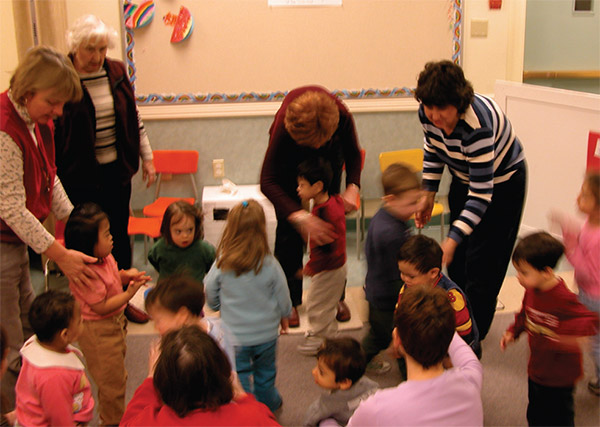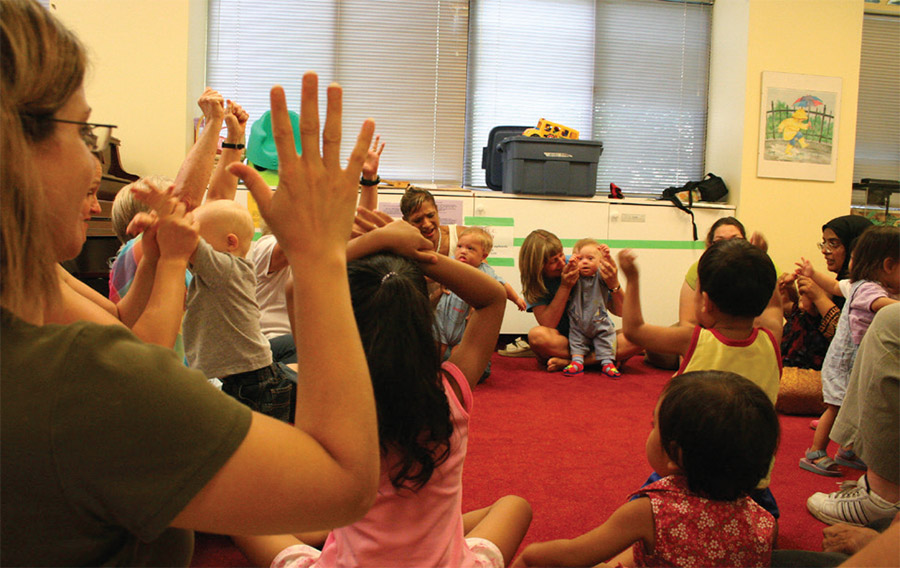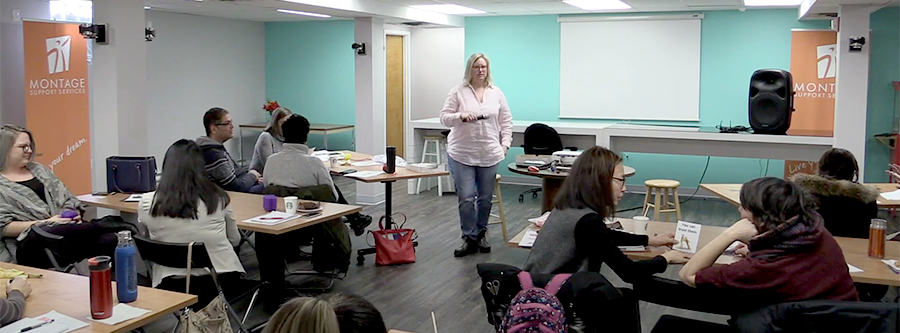
Plan
When to hold your music circle
Choosing the right time to hold your music circles will greatly aid in their success. Planning to have your music circle when the children are most alert and interested and when you have a full staffing complement to support the children, will provide the greatest learning opportunity.
Try not to use circles as a holding time during daily transitions as there are too many distractions and not enough staff resources to make the activity go well. When a holding circle is the only option available, try splitting the group into two, keeping each group separate, e.g., one group goes to the washroom first, then sits for circle while the second group has their circle and then washroom.
Where to hold your circle
Music circles are traditionally held on the carpet in a large gathering area.
Consider having small, spontaneous music groups throughout the day. This gives children extra practice at learning the songs they will hear in the large group. It also may reduce waiting times.
Points to consider: define the music circle space with the carpet or shelves as barriers, remove or cover up distractors (e.g., toys on nearby shelves), ensure that the space comfortably fits the group of children and that all the children can see you and you can see them. Seat all children on individual mats or chairs.
Length of circle
It is important to look at setting realistic goals for your group of children based on their developmental and learning goals. A five-minute dynamic circle can be more valuable than struggling to keep children interested for 25 minutes. The objective should be to stop when everyone is still interested and involved, not when they become bored, distracted and disruptive. If you stop in time they will eagerly await your next circle.
Props

Use props and materials as part of your planned circle time activities (e.g., puppets for a story, toys or objects for a song, scarves for creative movement). Let the children use the props as much as possible. This will help them to take part in the activity and to focus for a longer period of time. Keep all the circle time materials and props in a bin. Plan your songs before each circle. Bring the bin with you to each circle and the songs, props and visuals are ready to go at your fingertips. Rotate the materials in the bin on a regular basis to stimulate the children’s ongoing interest.
The use of props can promote children’s learning in a variety of areas. For e.g., cognitive skills such as counting (finger puppets for 5 Little Monkeys) and learning the alphabet (picture cards for Bingo), sensory awareness (spray bottle for Feel the Water), and social skills development for self-esteem and confidence building (pompom for hooray Song).
To transition between songs, sing “put the _____ in the basket, dear children” sung to the tune of “there’s a hole in my bucket”. If a child refuses to give the prop back, simply exchange that prop when the next one comes out or wait for that child to return the prop before giving them a turn.
Staffing

Talk with your teaching partner and if your program has volunteers/students to clarify their roles prior to music time. Establish one group leader and designate the others to support roles with specific children or to be evenly distributed in the group. The other adults can help by intervening if difficulties arise, and by coaching or modeling for individual children. This allows the leader to stay focused on the rest of the group and to keep the music circle flowing and fun. Encourage children to sit on their own spot, beside you, rather than on your lap. This will build independence and will ensure that you will be able to gradually remove/reduce your support as the child settles. It also leaves you free to move away quietly with little disruption if another child needs support.
When you don’t have a teaching partner, or you are fading support, try partnering a peer with a child who needs support.
Fidget Toys
For children who are having difficulty waiting, try shortening the length of the wait and give praise for even the shortest wait. You can gradually lengthen the waiting time.
Fidget toys help children who have difficulty sitting for circle. Having a small quiet toy in their hands helps them to stay focused and if their hands are busy they are less likely to disturb others in circle. When you first introduce fidget toys make sure you have enough for all the children. It will be a novelty at first, but after a while only those children who need them will use them.
Visual Supports

A visual support is information for our eyes that helps with communication. Children may not always understand spoken language, but they will almost always understand a picture or object. You may need to provide a variety of communication supports. One child might benefit from an actual object (e.g., a bus to represent Wheels on the Bus), while another child may need a photograph of the object, a picture from a magazine, a line drawing, or a picture symbol. By providing children with a visual of each song, you will be helping them anticipate and prepare themselves for what is about to happen. This allows children an increased ability to focus and participate. Remember to name the object or the picture when you introduce it and when a child uses it. When using a picture card, include a printed word(s) at the top of the photograph or picture symbol.
Choice-making is a great way to give children a sense of control and to build self-esteem.
Children can be given a choice between songs, props or instruments. Children may use different methods of making choices which could include sounds or words, or reaching for the item they wish to select. When presenting a child with a choice, it is important to remember to model the way in which you would like the child to choose and give ample time for the child to respond.
Music circle is a great opportunity to teach the important skill of turn-taking which is the building block for social skills. Not all children get a turn every time. Watching another child take a turn and sharing in that experience can be fun. However, it is important to ensure that all children get an equal opportunity for participation. Write each child’s name on a card or take a photo of each child. When it is time to pick a child, pick a card from the bag. When all children have had their card chosen from the bag then all cards go back in the bag. This process can take a day, a few days or all week to complete.
Behaviour
Rules
Setting some expectations helps children guide their behaviour. These expectations need to be simple, visual and concrete. A rule board is an easy way to review the expectations for the music circle, and ultimately the classroom. You can use any type of medium you wish to display the rules, including photos, picture symbols or drawings. The rules can then be posted in the classroom, in the area prepared for your music circle. Remember to keep things positive, describing the behaviour you would like to see. Only use a few rules, 2 or 3 is enough for children to focus on. At the beginning of every circle, review the rules with the group or ask the children to remember and tell the group one of the rules.
Transitions
Attention Getters: Try starting your circle with an “attention getter” such as a train whistle paired with the song “Join the Train For Circle”. This will help children transition to circle time smoothly and willingly.
Transition songs are just as important as other songs in your routine as they help children remain focused in between songs and create a clear beginning and end for each activity or song.
To get children to stand or sit for a particular song, try making it into a game, “When I say “purple pickles” we will all stand up! Ready…blue bananas…red raspberries…purple pickles!”
Try using the same songs to start and end your music circle so that children will be able to anticipate the transition. Singing the same songs does not bore children. They develop a sense of accomplishment as they master the words or actions and will be able to choose from the songs they know well. Start with a small pool of songs and introduce new ones slowly.
Movement Songs and Games

There are many benefits to exercise including increased flow of blood and oxygen to the brain, improved short-term memory, and faster reaction times. (Start Smart, Pam Schiller, 1999, Gryphon House) Limiting circles to activities where children are seated throughout results in difficulties focusing. Alternating sit down and whole body movement (e.g., Hokey Pokey) engages children and creates anticipation of upcoming activities. Gross motor games provide children with an opportunity to engage in physical activities (e.g., Row Your Boat), have unique sensory input (e.g., Catch the Bubbles) and shared group experiences (e.g., Parachute games).
Self-Regulation
Self-regulation is the nervous system’s ability to control one’s level of alertness according to the needs of the environment. There is a developmental sequence to learning self-regulation and as they mature, children learn to think before they act. Because self-regulation affects different developmental domains, regulation of one domain affects other areas of development. For example, infants translate the feel of soothing touch and the sound of soft voices (emotion) into cues (cognition) that help them develop self-calming skills. Toddlers and preschoolers begin to translate cues from adults, such as “Your turn is next,” into regulation that helps them inhibit urges to grab items. Children begin to learn how long they must usually wait to be served food or to have a turn playing with a desired toy, which helps them regulate and stabilize their response to situations.
Songs and games which require children to listen to directions and respond to them, teach self-regulation skills in a fun manner. For e.g., If You’re Angry song (to the tune of If You’re Happy) provides strategies for dealing with anger but also requires listening to directions to engage in the corresponding actions.
Cooperative Games
Cooperative games emphasize participation, challenge, and fun rather than competition. All participants engage together in activities and no one is left out. Such games help children attend to what is happening around the circle and respond to the activity. This develops children’s ability to focus on a joint experience, take turns, and wait for each other. For e.g., Simon Says can be played without tricking children and Musical Hula Hoops is similar to Musical Chairs, however all children can fit in the remaining hoop(s).
Story-Telling (find picture)
Story-telling used effectively can promote a host of skills including: enhanced listening, new vocabulary, thinking capacity, curiosity, increased memory and knowledge (of self and others, places, relationships), imagination, and a sense of wonder.
Therefore, it is important for you to identify the purpose of and when you use books. Have goals for your story time and choose books that are interactive. You can make reading more interesting through the use of related props. For e.g., when reading Eric Carle’s “The Very Hungry Caterpillar”, use toy fruit from your dramatic centre. The adult should be in control of the book and allot an appropriate length of time to complete the story with time for questions and discussion. Consider shortening the story if you feel the children’s attention is waning. Although sometimes unavoidable, exposure to books should not be limited to holding times. Story-telling does not have to be provided at every circle. It should be offered to children at least three times a week to encourage children’s love of books.




